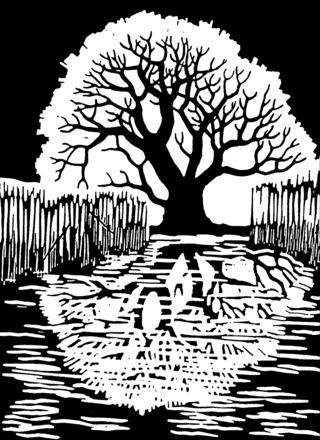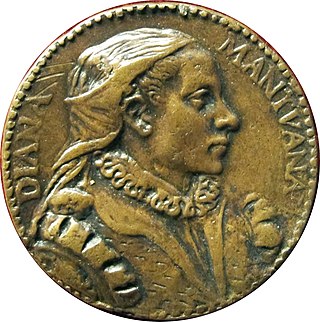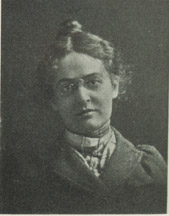
Linocut, also known as lino print, lino printing or linoleum art, is a printmaking technique, a variant of woodcut in which a sheet of linoleum is used for a relief surface. A design is cut into the linoleum surface with a sharp knife, V-shaped chisel or gouge, with the raised (uncarved) areas representing a reversal of the parts to show printed. The linoleum sheet is inked with a roller, and then impressed onto paper or fabric. The actual printing can be done by hand or with a printing press.

The Rhode Island School of Design is a private art and design school in Providence, Rhode Island. The school was founded as a coeducational institution in 1877 by Helen Adelia Rowe Metcalf, who sought to increase the accessibility of design education to women. Today, RISD offers bachelor's and master's degree programs across 19 majors and enrolls approximately 2,000 undergraduate and 500 graduate students. The Rhode Island School of Design Museum—which houses the school's art and design collections—is one of the largest college art museums in the United States.

Sybil Andrews was an English-Canadian artist who specialised in printmaking and is best known for her modernist linocuts.
Dame Eileen Rosemary Mayo was an English artist and designer who worked in England, Australia and New Zealand in almost every available medium – drawings, woodcuts, lithographs on stone and tempera, tapestry and silk screening. In addition to being a printmaker, illustrator, calligrapher and muralist, she designed coins, stamps, tapestry and posters, and wrote and illustrated eight books on natural science.

Nancy Elizabeth Prophet was an American artist of African-American and Native American ancestry, known for her sculpture. She was the first African-American graduate from the Rhode Island School of Design in 1918 and later studied at L'Ecole des Beaux-Arts in Paris during the early 1920s. She became noted for her work in Paris in the 1920s and 1930s. In 1934, Prophet began teaching at Spelman College, expanding the curriculum to include modeling and history of art and architecture. Prophet died in 1960 at the age of 70.

The Museum of Art, Rhode Island School of Design is an art museum integrated with the Rhode Island School of Design, in Providence, Rhode Island, US. The museum was co-founded with the school in 1877, and still shares multiple buildings and facilities. It is the 20th-largest art museum in the United States, and has seven curatorial departments.
Paul Hambleton Landacre was an active participant in the cultural flowering of interwar Los Angeles, described by Jake Zeitlin as a "small Renaissance, Southern California style". His artistic innovations and technical virtuosity gained wood engraving a foothold as a high art form in twentieth-century America. Landacre's linocuts and wood engravings of landscapes, still lifes, nudes, and abstractions are acclaimed for the beauty of their designs and a mastery of materials. He used the finest inks and imported handmade Japanese papers and, with a few exceptions, printed his wood engravings in his studio on a nineteenth-century Washington Hand Press, which is now in the collection of the International Printing Museum in Carson, California.

Diana Scultori, Diana Mantuana, or Diana Ghisi (1547–1612) was an Italian engraver from Mantua, Italy. She is one of the earliest known women printmakers, making mostly reproductive engravings of well-known paintings or drawings, especially those of Raphael and Giulio Romano, or ancient Roman sculptures.
Arthur S. Douglas, was an American landscape painter and printmaker and one of the earliest students at Rhode Island School of Design.

Meredith Stern is an artist, musician and DJ living in Providence, Rhode Island.
Jungil Hong also known as Jung-li Hong is a Korean-American artist based in Providence, Rhode Island. She is best known for her psychedelic, cartoon-inspired silkscreen poster art and paintings. More recently she has expanded into textiles.

Rosanne Somerson is an American-born woodworker, furniture designer/maker, educator, and former President of Rhode Island School of Design (RISD). An artist connected with the early years of the Studio Furniture, her work and career have been influential to the field.
Angie Lewin is a British printmaker working in linocut, wood engraving, lithography and screen printing.

Miriam Beerman was an American abstract expressionist painter and printmaker.
Leonard Beaumont (1891–1986) was an English printmaker, graphic designer, illustrator and publisher. He was one of the earliest exponents of the new art of linocut printmaking in Britain during the early 1930s. He was one of a small group of progressive and highly regarded printmakers who exhibited at the Redfern and Ward Galleries in central London. Whilst working in relative isolation in Yorkshire, most of his contemporaries were linked in some way to the Grosvenor School of Modern Art, located in Pimlico, London.
Andrew Stein Raftery is an American artist and educator, known for his paintings, burin engravings, and drawings on fictional and autobiographical narratives of contemporary American life.

Frances Gearhart was an American printmaker and watercolorist known for her boldly drawn and colored woodcut and linocut prints of American landscapes. Focused especially on California's coasts and mountains, this body of work has been called "a vibrant celebration of the western landscape." She is one of the most important American color block print artists of the early 20th century.
Carmel Vitullo is an American street photographer whose imagery of Rhode Island have been acquired for a number of collections.
Wilmer Angier Jennings (1910–1990) was an African-American printmaker, painter, and jeweler. He was hired by the Rhode Island WPA to create wood-engraved prints that explored themes of economic and social hardships experienced by African-Americans. Jennings' work also included Southern themes inspired by oral folklore traditions. During his later years, Jennings studied jewelry design, which prompted him to develop new methods of jewelry manufacturing.
Daphne Farago was an art collector and philanthropist.










